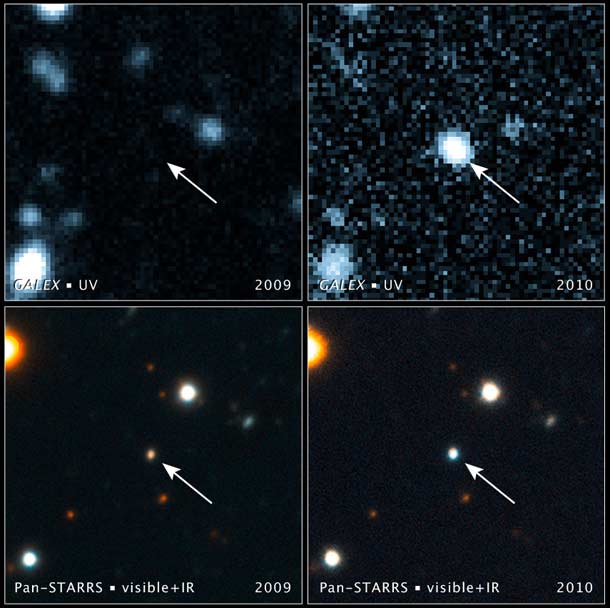Create a free profile to get unlimited access to exclusive videos, sweepstakes, and more!
Astronomers see ANOTHER star ripped apart by a black hole!

Last year, astronomers saw the violent death throes of a star as it was literally torn apart by a black hole (see here, and links within). And now they've seen it again: observations across the electromagnetic spectrum caught another star that wandered too close to a supermassive black hole and suffered the ultimate fate.
These observations show the before-and-after (left versus right) of the event. The top two are from GALEX, a satellite that observes the skies in the ultraviolet, and the bottom uses Pan-STARRS1, a powerful telescope (located on which mountain, you ask? Why, Haleakala in Hawaii, of course) that scans the entire night sky looking for transients, things that change brightness.
The light from the star's violent demise reached us in June of 2010. The event happened in the heart of a distant galaxy, 2.7 billion light years away. At the center of that galaxy is a black hole with millions of times the Sun's mass, comparable to the black hole in the center of our own Milky Way galaxy. The star apparently orbited the black hole in an elliptical orbit. Over millions or billions of years, the star evolved and turned into a red giant. Over time, its orbit tightened, and one day it got too close. The enormous tides of the black hole tore the star apart.
The flare happened when the stellar material spiraled into the hole. It formed a flattened disk right before the Ultimate Plunge, which got very hot and blasted out high-energy light -- the ultraviolet light from this galaxy flared 350 times brighter than it was before! Some of the material from the star was also flung away into space. Astronomers put together a nifty video simulating what happened:
[You can watch a high-def version of this on the Hubble site.]
The material ejected was determined to be mostly helium, a sure sign that the star was old; stars start out mostly hydrogen, and slowly convert it to helium over time.
Events like this are rare; they probably only happen every 100,000 years or so per galaxy. So the astronomers looked at 100,000 galaxies, giving them good odds they'd see something like this once per year. Their gamble paid off.
In 2011 the Swift satellite saw a star that met a similar demise; Swift's advantage is that it scans the sky rapidly and can view huge chunks of it at a time. This was probably the first time anything like that had been seen. It takes time to look over the data and make sure it's not some other more normal event like a supernova or flare from a black hole as it eats a gas cloud.
Hmph. "Normal." Right. I guess compared to a star ripped to shreds by the ferocious gravity from a supermassive black hole, yeah, a supernova is pretty normal. What a way to go either way, though!
Rare events are hard to witness unless you have a keen eye and watch the whole sky. The reason something this was never seen before is that it's only with modern tech -- bigger telescopes with digital detectors plus satellites tuned to different wavelengths of light -- that we can see them at all. This was literally impossible to see even 20 years ago.
And our technology is getting better all the time! What other fantastically rare and über-violent events are going on out there in deep space, just waiting for us to see them?
Credit: NASA, S. Gezari (The Johns Hopkins University), A. Rest (STScI), and R. Chornock (Harvard-Smithsonian Center for Astrophysics)



























